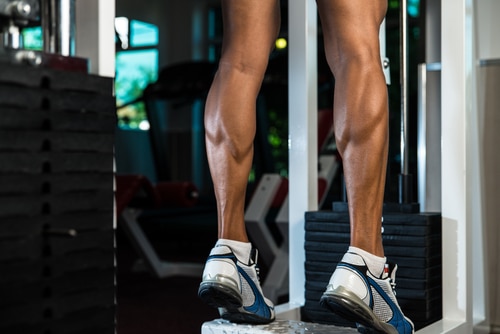
Why is this a problem? By focusing more on your favorite muscles, you creating strength imbalances. Strength imbalances are a problem because they increase your risk of injury. Strength imbalances also create asymmetry. A symmetrical balanced body in terms of strength and development is better from a structural standpoint and is more aesthetically pleasing as well. Muscles work together in an integrated manner to help you move. If one muscle is weaker it throws movements slightly off balance and increases the risk of injury
What muscles are you not working often enough? In terms of muscle balance, some muscles are more likely to get the “cold shaft” than others. Here are some of the most commonly neglected muscle groups:
Resistance Training: Calves
Chances are you invest more of time working your quadriceps and hamstrings than you do your calf muscles. Your calf is made up of two muscles gastrocnemius and the soleus. Strong calf muscles are important if you do sports that require explosive power like jumping. Always stretch your calf muscles after every workout to maintain flexibility, especially if you run or do plyometric exercises that involve jumping.
Fortunately, it’s easy to work your calf muscles by doing standing or seated calf raises. The results you’ll get from working your calf muscles will vary. Some people develop calf muscles more easily than others based on genetics. Even if you don’t develop noticeably defined calves, you can still strengthen them for greater muscle balance and symmetry. Why should your quads and hamstrings get all the attention? Add some calf raises, with or without weights, to your lower body routine.
Resistance Training: Obliques
The obliques are another group of neglected muscles for some people. The oblique muscles, made up of the internal and external obliques, are muscles on each side of your rectus abdominis. Why do you need to work them? They give your lower back support and help to improve your posture. Plus, your obliques come into play as stabilizers when you do other types of lifting movements.
Two of the best exercises for working your obliques are oblique crunches on a mat or a stability ball and side planks. Don’t let your obliques be an afterthought. Side bridges and Russian twists also target your oblique muscles. For overall core balance, don’t make your obliques an afterthought.
Resistance Training: Lower Back Muscles
When you work your abdominal muscles and obliques, save some focused attention for your back. By zeroing in on your abdominal muscles without training your lower back muscles, you create a core imbalance that increases your risk for injury and back pain. After all, back muscles are part of your core. When you focus on abdominal exercises without balancing things out with lower back exercises, your core becomes “off-balance,” being stronger on one side than the other. Your goal should be core symmetry. Plus, strong back muscles provide the support you need to train other muscles harder by supporting your spine. When your spinal stabilizers are weak it affects your posture. This places added stress on your vertebrae. Not to mention strong back muscles reduce your risk for back pain.
How can you give your lower back muscles more love? Balance abdominal exercises with “supermans.” To do this, lie on your stomach and lift your shoulders off the floor as high as you can. Hold for a few seconds before releasing. Repeat until you can’t do anymore. Deadlifts are another good exercise for strengthening your lower back muscles.
Resistance Training: Forearms
Forearms you say? Why do I need to work them? Strong forearms reduce fatigue when you train your biceps and when you do presses. They also improve your grip strength – perfect if you play racquet sports or if you do pulling exercises. Having weak forearms can limit the amount of weight you can lift when working other body parts. Don’t let your forearms limit your development in other areas.
Among the best exercises for strengthening your forearms are wrist flexion and extension exercises using weights. When you do biceps curls, add a set of reverse barbell curls to strengthen the extensor muscles in your forearms. There’s no need to spend a large amount of time working your forearms, but don’t ignore them either. They help you maximize the rest of your resistance training.
Resistance Training: The Importance of Total Body Workouts
One way to make sure no muscle gets left behind is to focus more on total body workouts and compound exercises that work multiple muscle groups. You’ll also burn more calories doing a greater percentage of compound exercise as opposed to exercises that isolate a single muscle group. Still, if you already have muscle imbalances because you’ve ignored certain muscles, you’ll need to do isolated exercises that target those muscles to create muscle balance.
The Bottom Line
Everyone has favorite body parts that they love to work more than others. Enjoy resistance training those parts but don’t neglect ones you don’t like to work and those you deem less important. It’s also about balance and symmetry. Your body is only as strong and powerful as its weakest link. Make sure your training is balanced.
References:
ACE Fitness. “Muscular Imbalances Increase Your Clients’ Risk for Injury”
Related Articles By Cathe:
Strength Training: Avoid These 5 Mistakes When Lifting Heavy
5 Ways to Make Bodyweight Exercises More Effective
4 Common Mistakes Women Make When Training with Weights
How Often Should You Change Your Strength Training Routine?
6 Full Body Exercises That Double as Cardio
5 Ways to Maximize the Results You Get When You Fitness Train
Related Cathe Friedrich Workout DVDs:
STS Strength 90 Day Workout Program
All of Cathe’s Strength & Toning Workout DVDs
Total Body Workouts
Lower Body Workouts
Upper Body Workouts

